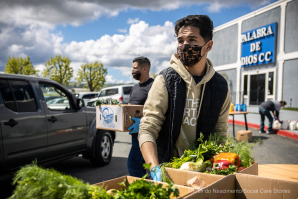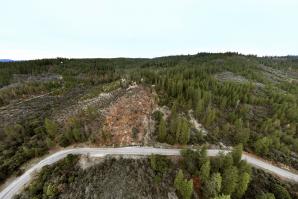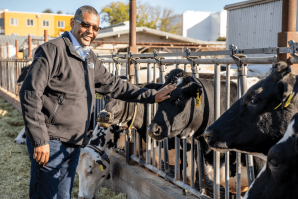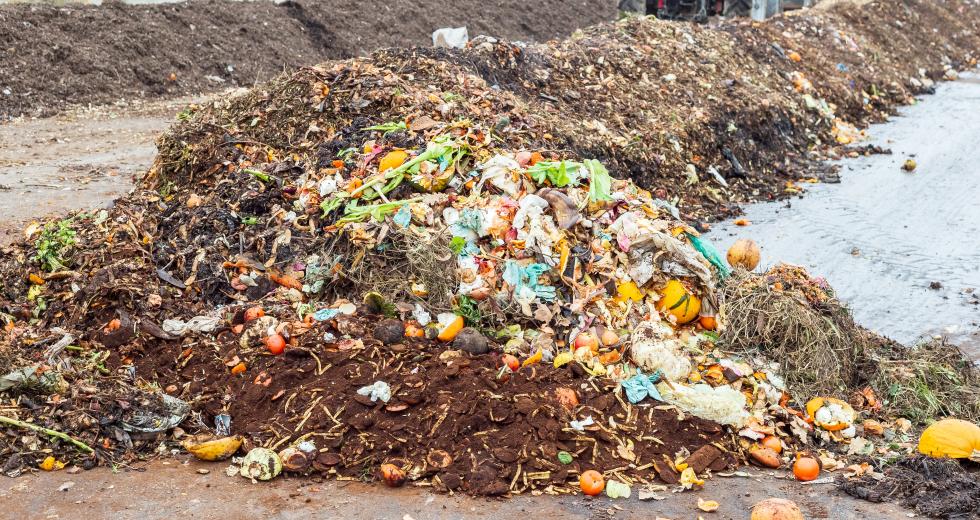Separating food waste from trash used to be the stuff of hippies. Environmentally conscious consumers might use food waste for mulching homegrown tomatoes or drop it off during a weekly trip to the farmer’s market. But, like wearing Birkenstocks or bringing your own bag to the supermarket, collecting egg shells and carrot stems in a countertop pail is now mainstream. And, unlike cork sandals, it’s not a matter of taste — it’s state law.
The implementation of mandatory food scrap recovery dates back to 2016, when the state senate passed Senate Bill 1383. The law aims to decrease fossil fuel emissions from landfills, by diverting 75 percent of food waste from landfills by 2025. Food waste is of particular importance because, when left in a landfill, it is broken down by bacteria which produce methane, a greenhouse gas with 28 times the warming potential of carbon dioxide.
Under the new law, this waste will meet a better fate: Pre-consumer, edible food waste will be redirected to food banks, helping to combat food insecurity. Post-consumer food waste will replenish soil as compost, power trucks as natural gas, or feed livestock — turning waste into a resource for the state’s agricultural industry.
In the period from June to September, the City of Sacramento saw a 14 percent increase in organic waste collected, and a 10 percent decrease in garbage collected.The county saw a 16 percent increase in organic waste collected between implementation, in July 2022, and December, compared with the same period in the previous year, and a 16 percent decrease in garbage collected in the same window.
Still, Brenda Bongiorno, a spokesperson for the county’s Department of Waste Management and Recycling, warns that the amount of organic waste collected does not differentiate between food and yard waste, making it subject to seasonal fluctuations in greenery waste and difficult to see the full impact of the new program.
Furthermore, Rachel Wagoner, director of CalRecycle, says that “six months of data is not a very good story about changes in behavior.”
“It’ll be another year before we can really measure how Sacramento is doing,” she says.
At the end of 2021, however, CalRecycle estimated that 56 percent of landfill waste is organic — meaning that even if the 10 percent decrease in landfill waste from Sacramento was all redirected food waste, the city still has a long way to go.
Marissa Juhler, interim director for landfill operations and waste reduction at the Yolo County Central Landfill, one of three sites to which Sacramento County sends its organic waste, sees the learning curve as similar to that of other kinds of recycling.
“Plastics recycling started in the seventies, and it has taken four or five decades to get it right,” she says. The state’s goal is to divert 75 percent of organic waste by 2025. The point of beginning early is to give people time to change their habits.
“By 2024, everyone should be diverting organics perfectly,” says Juhler.
Juhler believes that the number one challenge is education, both to decrease contamination — or trash found in the organic waste stream — and to increase yields. “We need to get people to realize that not only is this the law, it’s the right thing to do,” says Juhler.
Education doesn’t only refer to flyers and videos about what can and cannot be recycled. Juhler believes increasing yields will require getting people excited about composting. Her facility gives out free compost to residents twice a year to allow them to reap the benefits of the changes they’re being asked to make.
“By 2024, everyone should be diverting organics perfectly.”
Marissa Juhler, interim director for landfill operations and waste reduction, Yolo County Central Landfill
Cultivating excitement is difficult when organic waste collection not only requires learning new rules, but also comes at a cost. In Sacramento City, for example, monthly rates increased in April, from $42.59 to $46.42 for garbage, recycling and organics collection. Rates will increase once again in January 2024, to $54.08.
Organics recycling is more expensive than burying waste in a landfill, but the increased cost is also related to contamination levels, says Juhler. Every load of garbage pulled out of the organic waste costs $78 a ton to bury.
“There’s no way for us to think of lowering or stabilizing rates if contamination remains high,” she says, because the rates have to be high enough to cover disposal of contamination.
Removing non-organic garbage from organic waste involves a line of workers, who pull out as much as they can before the material is shredded and goes to the compost pile. Once it goes through machines, any plastic or other contamination is in a million pieces and is nearly impossible to recover.
In July, contamination of organic waste at the Yolo facility was 30 percent — “which is horrible,” Juhler says. By February, 2023, this had decreased to around 13 percent, but Juhler says that a facility should not have more than 5 percent, and that the goal is 1 percent.
Joseph Yonkoski, an engineer who works at UC Davis’ biodigester, echoed this sentiment.“The big thing is reducing contamination, which will make processing easier and less costly,” he says. “It’s more effort on their end but better on the whole.”
A tank at Yonkoski’s facility has been out of commission for over a year, because of contaminants that built up in the tank. The facility is processing less waste than it could as a result, as it will be costly to hire the vacuum service necessary to clean out the tank.
Another part of education around decreasing contamination is the “route review” mandated by the law, or what Juhler calls “flip the lid.” This means opening up residential organic waste carts to see how much contamination is in them. Juhler sees Styrofoam cups, several kinds of plastics (cups, utensils, straws), soup cartons, juice boxes and shelf-stable cartons. “People think anything that touches food can be composted,” she says, though only food-soiled paper, such as plates, napkins and cardboard are accepted.
She says that flipping lids is effective, but costly, as it involves a lot of labor and staff time. She goes out with her crew, sampling 35-50 homes per day. Some people will come out of their houses and thank the crew, and some tell them they have no right to touch their trash.
Juhler says another important area of focus is to educate people not to use plastic bags to collect organic waste, but instead to buy compostable bags or use paper bags. Juhler’s facility even provides bags for residents, which they can pick up for free from Monday to Friday.
Sacramento has enough capacity to handle all its organic waste, according to both Wagoner and Juhler. In fact, facilities in the Capital Region are processing waste from other parts of the state, including the Bay Area.
Although organics recovered are expected to increase over the next few years as behavior changes, regions with less capacity are expected to build out infrastructure to process their own waste, leaving more room for processing local material at regional facilities.
What the Capital Region needs to improve is food rescue capacity, says Wagoner. Edible food recovery is part of SB 1383, which seeks to divert 20 percent of what is edible to food banks. Although the average family of four wastes $1,500 worth of food every year, not all Californians are so lucky. There are 3,571,920 food insecure Californians, including 179,280 in Sacramento County.
The law has required large supermarkets and food distributors to contract with local nonprofits since January 2022, with restaurants, hotels and schools expected to follow in January 2024. The county has reported that it is not in compliance with food recovery requirements, meaning that it was not able to recover the amount it reported it would in its plan.
The law requires that waste generators secure contracts with food banks to recover food that would otherwise be disposed of and to keep records of the types of food collected, frequency of collection and monthly pounds of food collected.
Joel Wilkerson, a food safety manager at Produce Express, a wholesale food distributor in the region which is contracted with the Yolo Food Bank, says that one of the biggest hurdles to implementation is scheduling and transportation.
“Our experience is that some food banks will only accept donations during certain time windows or want firm times and dates for pick ups, which are difficult to align without disrupting our primary operational goals,” says Wilkerson.
Wilkerson believes that in order to increase edible food recovery, it would be helpful if charitable organizations were able to go onsite to the distribution facility and sort through and take what is acceptable for donation. “With the rising cost of labor and labor shortage, distributors are less likely to have the ability to sort food for donation and deliver it to a food bank,” he says.
This sentiment was echoed by Tim Baumbach, who helps run the California Emergency Foodlink, which collects, stores and distributes food to local food banks. “You have to go to them,” he says. “If you keep denying and turning them down, companies will go elsewhere or dump the food instead.”
“We get calls from people donating, saying they’ve called several food banks and none were receptive. We try to make ourselves receptive all the time,” Baumbach continues.
He understands the difficulties smaller organizations face, though: “It’s hard to go get it, it’s hard to manage it, it’s hard to store it.” Thankfully, CEFL has five trucks and 500,000 square feet of storage, including refrigeration and freezers.
Baumbach says with more resources — particularly labor — CEFL could recover even more food. The organization recovered 892.5 tons of food in 2022, and is on track to surpass that in 2023.
Sacramento Food Bank & Family Services recovered 12,427 tons of edible food in 2021, but only 12,150 tons in 2022, after the new law was implemented. Kevin Buffalino, a spokesperson for the organization, attributed this decrease to Tier One waste generators streamlining operations to reduce waste by implementing in-house composting and adjusting inventory, decreasing the amount of edible food available for grocery recovery.
Although the state still has progress to make, the Capital Region is staying ahead of the curve. “Some counties haven’t even put a bin at the curbside,” says Juhler. “We have a way to go, but we’ve already made so much progress.”
–
Stay up to date on business in the Capital Region: Subscribe to the Comstock’s newsletter today.
Recommended For You

What a Waste
Californians throw away 11 billion pounds of food each year — a new recycling law aims to reuse it
Food waste recycling is vital to transforming California
into a circular economy. City and state organizations are
creating mandates to get us there.

Fuel From the Forest
Can bioenergy technology combined with innovations in finance fuel forest restoration in the Tahoe National Forest?
A new project in the North Yuba Forest is developing a local economy built on wood and other biomass clogging the forest.

Who Will Save (Not Stop) the Rain?
California has always been celebrated for Innovation, yet we can’t budge our elected leaders to truly innovate much of anything, states Comstock’s president and publisher. In this month’s letter, she considers the complicated issue that is our state’s water dilemma.

A Sea of Hope
Can seaweed reduce the greenhouse gas emissions of California’s dairy industry?
In the span of a year, a single cow burps up 220 pounds of methane, a powerful driver of global warming. UC Davis scientists are experimenting with a red seaweed that can dramatically reduce the methane, but the solution has a few caveats.



